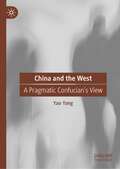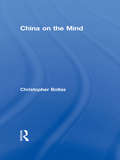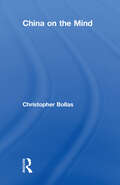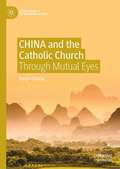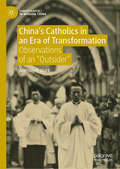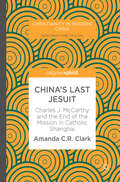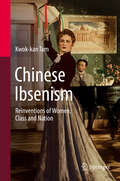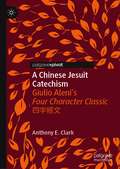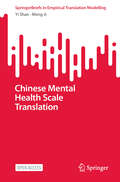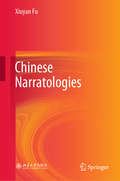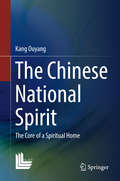- Table View
- List View
China and the True Jesus: Charisma and Organization in a Chinese Christian Church
by Melissa Wei-Tsing InouyeIn 1917, the Beijing silk merchant Wei Enbo's vision of Jesus sparked a religious revival, characterized by healings, exorcisms, tongues-speaking, and, most provocatively, a call for a return to authentic Christianity that challenged the Western missionary establishment in China. This revival gave rise to the True Jesus Church, China's first major native denomination. The church was one of the earliest Chinese expressions of the twentieth century charismatic and Pentecostal tradition which is now the dominant mode of twenty-first century Chinese Christianity. To understand the faith of millions of Chinese Christians today, we must understand how this particular form of Chinese community took root and flourished even throughout the wrenching changes and dislocations of the past century. The church's history links together key themes in modern Chinese social history, such as longstanding cultural exchange between China and the West, imperialism and globalization, game-changing advances in transport and communications technology, and the relationship between religious movements and the state in the late Qing (circa 1850-1911), Republican (1912-1949), and Communist (1950-present-day) eras. Vivid storytelling highlights shifts and tensions within Chinese society on a human scale. How did mounting foreign incursions and domestic crises pave the way for Wei Enbo, a rural farmhand, to become a wealthy merchant in the early 1900s? Why did women in the 1920s and 30s, such as an orphaned girl named Yang Zhendao, devote themselves so wholeheartedly to a patriarchal religious system? What kinds of pressures induced church leaders in a meeting in the 1950s to agree that "Comrade Stalin" had saved many more people than Jesus? This book tells the striking but also familiar tale of the promise and peril attending the collective pursuit of the extraordinary-how individuals within the True Jesus Church in China over the past century have sought to muster divine and human resources to transform their world.
China and the West: A Pragmatic Confucian’s View
by Yao YangThis is an authored volume of Dr. Yao's “big-picture” writings on China and the West, translated by David Ownby. Those writings are selected from his writings as a public intellectual, reflecting his thought on China’s path of modernization and the effort to rebuild a political philosophy based on Confucianism, his interpretation of China’s political system and his prescriptions to improve it. A moderate, yet influential scholar, Yao's work has had great influence on Chinese social and economic policymakers; his project of renewing China's traditional value system is an important position, as Chinese reforms begin to focus on equity and inclusion. In an engaging, at times personal, and thoughtful volume, Dr. Yao's vision of a gentler Chinese society will interest Sinologists, political scientists, and journalists.
China on the Mind
by Christopher BollasSeveral thousand years ago Indo-European culture diverged into two ways of thinking; one went West, the other East. Tracing their differences, Christopher Bollas examines how these mentalities are now converging once again, notably in the practice of psychoanalysis. Creating a freely associated comparison between western psychoanalysts and eastern philosophers, Bollas demonstrates how the Eastern use of poetry evolved as a collective way to house the individual self. On one hand he links this tradition to the psychoanalytic praxes of Winnicott and Khan, which he relates to Daoism in their privileging of solitude and non verbal forms of communicating. On the other, Bollas examines how Jung, Bion and Rosenfeld, assimilate the Confucian ethic that sees the individual and group mind as a collective, while Freudian psychoanalysis he argues has provided an unconscious meeting place of both viewpoints. Bollas’s intriguing book will be of interest to psychotherapists, psychoanalysts, Orientalists, and those concerned with cultural studies.
China on the Mind
by Christopher BollasSeveral thousand years ago Indo-European culture diverged into two ways of thinking; one went West, the other East. Tracing their differences, Christopher Bollas examines how these mentalities are now converging once again, notably in the practice of psychoanalysis. Creating a freely associated comparison between western psychoanalysts and eastern philosophers, Bollas demonstrates how the Eastern use of poetry evolved as a collective way to house the individual self. On one hand he links this tradition to the psychoanalytic praxes of Winnicott and Khan, which he relates to Daoism in their privileging of solitude and non verbal forms of communicating. On the other, Bollas examines how Jung, Bion and Rosenfeld, assimilate the Confucian ethic that sees the individual and group mind as a collective, while Freudian psychoanalysis he argues has provided an unconscious meeting place of both viewpoints. Bollas’s intriguing book will be of interest to psychotherapists, psychoanalysts, Orientalists, and those concerned with cultural studies.
CHINA and the Catholic Church: Through Mutual Eyes (Christianity in Modern China)
by Sergio TicozziThe volume approaches the relations between China and the Catholic Church in a quite comprehensive and unprejudiced way. Its approach is new since it clarifies the root of the persistent antagonism of both the imperial and republican Chinese Authorities toward the Catholic Church: no matter how the Catholic approach has been, they kept their Sino-centric attitude. It also points out the lack of a truly objective and complete understanding of China by the Western society, including Catholic missionaries: from a blind admiration to a negative evaluation, determined by contingent circumstances and motivations. It tries to clarify myths and stereotyped understandings, that have been created during the historical process, including the role of the Jesuits and in particular of Fr. Matteo Ricci. It also pays particular attention to the role of the Vatican in the recent religious policy of Chinese Government. The reading of the book could be enlightening especially for academics, university students and Christian clergy interested in the history of Catholic Missions in China.
China’s Catholics in an Era of Transformation: Observations of an “Outsider” (Christianity in Modern China)
by Anthony E. ClarkThis book features a collection of essays on China’s modern Catholic Church by a scholar of China-West intellectual and religious exchange. The essays and reflections were mostly written in China while the author was traveling by train, or staying in villages or large cities near to Roman Catholic cathedrals or other important historical sites during research trips to the country. It is clear that Clark’s understanding of Catholicism in China evolved from the first entry to the final ones in 2019. The essays included in this compendium were written in disparate contexts and in response to different events. As such, there is no obvious theme or order to the content. However, despite this, the book provides valuable insights for readers wishing to gain a better understanding of the complex topography of Catholic history in China, the contours of which have undergone stark transformations with each dynastic, political, and ecclesial transition. The information presented serves to highlight and explain the lives of Catholic people and the events that have punctuated one of the most significant dimensions of China’s long history of friendship, conflict and exchange with the West.
China’s Last Jesuit: Charles J. McCarthy and the End of the Mission in Catholic Shanghai
by Amanda C. ClarkThis pivot chronicles the life of Charles McCarthy, a San Francisco native and Jesuit missionary to China, and tells the unique and compelling story of a young man who experienced confinement under the Japanese occupation, followed shortly by imprisonment by the Chinese Communists in the 1950’s. Through a study of McCarthy’s unique epistolary exchanges, it considers the intellectual life of a Catholic missionary, his ongoing fight for equal citizenship rights, illustrating how American Catholic missionaries in Maoist-era Shanghai navigated the social tensions of a nation-state in turbulent transition. This narrative explores Jesuit strategies of resistance and persistence in an era of oppression, and ideological and religious conflict as those sent to fill the missionary spots left by European men lost in the World Wars were caught up in China’s mid-century political upheavals.
China’s Last Jesuit: Charles J. McCarthy and the End of the Mission in Catholic Shanghai
by Amanda C. ClarkThis pivot chronicles the life of Charles McCarthy, a San Francisco native and Jesuit missionary to China, and tells the unique and compelling story of a young man who experienced confinement under the Japanese occupation, followed shortly by imprisonment by the Chinese Communists in the 1950’s. Through a study of McCarthy’s unique epistolary exchanges, it considers the intellectual life of a Catholic missionary, his ongoing fight for equal citizenship rights, illustrating how American Catholic missionaries in Maoist-era Shanghai navigated the social tensions of a nation-state in turbulent transition. This narrative explores Jesuit strategies of resistance and persistence in an era of oppression, and ideological and religious conflict as those sent to fill the missionary spots left by European men lost in the World Wars were caught up in China’s mid-century political upheavals.
China's Muslims and Japan's Empire: Centering Islam in World War II (Islamic Civilization and Muslim Networks)
by Kelly A. HammondIn this transnational history of World War II, Kelly A. Hammond places Sino-Muslims at the center of imperial Japan's challenges to Chinese nation-building efforts. Revealing the little-known story of Japan's interest in Islam during its occupation of North China, Hammond shows how imperial Japanese aimed to defeat the Chinese Nationalists in winning the hearts and minds of Sino-Muslims, a vital minority population. Offering programs that presented themselves as protectors of Islam, the Japanese aimed to provide Muslims with a viable alternative—and, at the same time, to create new Muslim consumer markets that would, the Japanese hoped, act to subvert the existing global capitalist world order and destabilize the Soviets. This history can be told only by reinstating agency to Muslims in China who became active participants in the brokering and political jockeying between the Chinese Nationalists and the Japanese Empire. Hammond argues that the competition for their loyalty was central to the creation of the ethnoreligious identity of Muslims living on the Chinese mainland. Their wartime experience ultimately helped shape the formation of Sino-Muslims' religious identities within global Islamic networks, as well as their incorporation into the Chinese state, where the conditions of that incorporation remain unstable and contested to this day.
Chinese and Buddhist Philosophy in Early Twentieth-Century German Thought
by Eric S. NelsonPresenting a comprehensive portrayal of the reading of Chinese and Buddhist philosophy in early twentieth-century German thought, Chinese and Buddhist Philosophy in Early Twentieth-Century German Thought examines the implications of these readings for contemporary issues in comparative and intercultural philosophy.Through a series of case studies from the late 19th-century and early 20th-century, Eric Nelson focuses on the reception and uses of Confucianism, Daoism, and Buddhism in German philosophy, covering figures as diverse as Buber, Heidegger, and Misch. He argues that the growing intertextuality between traditions cannot be appropriately interpreted through notions of exclusive identities, closed horizons, or unitary traditions. Providing an account of the context, motivations, and hermeneutical strategies of early twentieth-century European thinkers' interpretation of Asian philosophy, Nelson also throws new light on the question of the relation between Heidegger and Asian philosophy. Reflecting the growing interest in the possibility of intercultural and global philosophy, Chinese and Buddhist Philosophy in Early Twentieth-Century German Thought opens up the possibility of a more inclusive intercultural conception of philosophy.
Chinese and Buddhist Philosophy in Early Twentieth-Century German Thought
by Eric S. NelsonPresenting a comprehensive portrayal of the reading of Chinese and Buddhist philosophy in early twentieth-century German thought, Chinese and Buddhist Philosophy in Early Twentieth-Century German Thought examines the implications of these readings for contemporary issues in comparative and intercultural philosophy.Through a series of case studies from the late 19th-century and early 20th-century, Eric Nelson focuses on the reception and uses of Confucianism, Daoism, and Buddhism in German philosophy, covering figures as diverse as Buber, Heidegger, and Misch. He argues that the growing intertextuality between traditions cannot be appropriately interpreted through notions of exclusive identities, closed horizons, or unitary traditions. Providing an account of the context, motivations, and hermeneutical strategies of early twentieth-century European thinkers' interpretation of Asian philosophy, Nelson also throws new light on the question of the relation between Heidegger and Asian philosophy. Reflecting the growing interest in the possibility of intercultural and global philosophy, Chinese and Buddhist Philosophy in Early Twentieth-Century German Thought opens up the possibility of a more inclusive intercultural conception of philosophy.
The Chinese Book of Animal Powers (PDF)
by Chungliang Al HuangFor thousands of years, the Chinese have believed that each of us is born with the characteristics and powers of a member of the animal kingdom, depending on the month and year of our birth. Now readers of all ages can discover for themselves the fun and wisdom of this age-old Chinese tradition in this exquisite book by celebrated author and artist Chungliang Al Huang. Find out which animal powers you were born with and which powers your friends and family possess. Discover how to absorb and adapt other animal powers into your own. Have fun pronouncing Chinese names with sounds that date back to ancient times. Feel each animal's graceful movements by tracing elegant brush calligraphy. With a full-page spread devoted to each animal, a glossary of movement and art, and an easy-to-use year and month chart, The Chinese Book of Animal Powers is a unique introduction to the Chinese Zodiac by an expert teacher and philosopher.
Chinese Buddhism and Traditional Culture (China Perspectives)
by Litian FangSince the first century, when Buddhism entered China, the foreign religion has influenced and been influenced in turn by traditional Chinese culture, and eventually became an important part of it. That is one of the great historical themes not only for China but also for East Asia. This book explores the elements of Buddhism, including its classics, doctrines, system, and rituals, to reveal the basic connotation of Buddhism as a cultural entity. Regarding the development of Buddhism in China, it traces the spread in chronological order, from the introduction in Han Dynasties (202 BC–220 AD), to the prosperity in the Sixteen Kingdoms (ca. 304–439 AD), and then to the decline since the Five Dynasties (907–ca. 960 AD). It is noteworthy that the Buddhist schools in the Southern and Northern Dynasties (420–589 AD) and the Buddhist sects in Sui and Tang Dynasties (581–907 AD) contributed to the sinicization of Buddhism. This book also deals with the interesting question of the similarities and differences between Chinese Buddhism and Indian Buddhism, to examine the specific characters of the former in terms of thought and culture. In the last chapter, the external influence of Chinese Buddhism in East Asia is studied. Scholars and students in Buddhism and Chinese culture studies, especially those in Buddhist countries, will benefit from the book. Also, it will appeal to readers interested in religion, Chinese culture, and ancient Chinese history.
Chinese Buddhism and Traditional Culture (China Perspectives)
by Litian FangSince the first century, when Buddhism entered China, the foreign religion has influenced and been influenced in turn by traditional Chinese culture, and eventually became an important part of it. That is one of the great historical themes not only for China but also for East Asia. This book explores the elements of Buddhism, including its classics, doctrines, system, and rituals, to reveal the basic connotation of Buddhism as a cultural entity. Regarding the development of Buddhism in China, it traces the spread in chronological order, from the introduction in Han Dynasties (202 BC–220 AD), to the prosperity in the Sixteen Kingdoms (ca. 304–439 AD), and then to the decline since the Five Dynasties (907–ca. 960 AD). It is noteworthy that the Buddhist schools in the Southern and Northern Dynasties (420–589 AD) and the Buddhist sects in Sui and Tang Dynasties (581–907 AD) contributed to the sinicization of Buddhism. This book also deals with the interesting question of the similarities and differences between Chinese Buddhism and Indian Buddhism, to examine the specific characters of the former in terms of thought and culture. In the last chapter, the external influence of Chinese Buddhism in East Asia is studied. Scholars and students in Buddhism and Chinese culture studies, especially those in Buddhist countries, will benefit from the book. Also, it will appeal to readers interested in religion, Chinese culture, and ancient Chinese history.
The Chinese Face of Jesus Christ: Volume 4b Supplementary Anthology General Index Addenda (Monumenta Serica Monograph Series)
by Roman MalekThis volume completes the previous volumes 1, 2, 3a, 3b, and 4a of an interdisciplinary book project on the reception of Jesus Christ in China, as seen from the perspectives of Sinology, mission history, theology, and art history, among others. It consists of the following parts: A "Supplementary Anthology" that presents excerpts and longer quotations from selected works – such as translations, prayers, poems, and scholarly articles – listed in the bibliography of vol. 4a; two sections of "Notes on Contributors, Vols. 1–3b" and "Notes on Authors of the Anthologies, Vols. 1–3b, 4b" that provide short biographical information on the contributors of articles and authors of all texts in the anthologies; a "List of Reviews of Vols. 1–4a" published on the whole collection as well as on individual volumes; the Tables of Contents of vols. 1, 2, 3a, 3b and 4a; a "General Index and Glossary" that gives readers access to all articles and anthologies included in vols. 1, 2, 3a, 3b, and 4b, a corpus of almost two thousand pages of text; and finally a list of "Errata and Corrigenda."
The Chinese Face of Jesus Christ: Volume 1
by Roman MalekThe Chinese Face of Jesus Christ: Volume 1
Chinese Ibsenism: Reinventions of Women, Class and Nation
by Kwok-kan TamThis book is a study of the relation between theatre art and ideology in the Chinese experimentations with new selfhood as a result of Ibsen’s impact. It also explores Ibsenian notions of self, women and gender in China and provides an illuminating study of Chinese theatre as a public sphere in the dissemination of radical ideas. Ibsen is the major source of modern Chinese selfhood which carries notions of personal and social liberation and has exerted great impacts on Chinese revolutions since the beginning of the twentieth century. Ibsen’s idea of the self as an individual has led to various experimentations in theatre, film and fiction to project new notions of selfhood, in particular women’s selfhood, throughout the history of modern China. Even today, China is experimenting with Ibsen’s notions of gender, power, individualism and self.Kwok-kan Tam is Chair Professor of English and Dean of Humanities and Social Science at the Hang Seng University of Hong Kong. He was Head (2012-18) and is currently a member of the International Ibsen Committee, University of Oslo. He is a Foundation Fellow of the Hong Kong Academy of the Humanities. He has held teaching, research and administrative positions in various institutions, including the East-West Center, the Chinese University of Hong Kong and the Open University of Hong Kong. He has published numerous books and articles on Ibsen, Gao Xingjian, modern drama, Chinese film, postcolonial literature, and world Englishes. His recent books include Ibsen, Power and the Self: Postsocialist Experimentations in Stage Performance and Film (2019), The Englishized Subject: Postcolonial Writings in Hong Kong, Singapore and Malaysia (2019), and a co-edited volume Fate and Prognostication in the Chinese Literary Imagination (2019).
Chinese Islam: Models of Interaction with State and Society (Global Islamic Cultures)
by Nasr M. Arif Shaojin ChaiThis book explores the fascinating and complex histories of Islam and China. Meticulously researched and captivating, it provides a comprehensive history of the encounters and relationship between these two great civilizations, as well as the unique development and indigenization of Islam within China.The work looks at the early interactions between Arab Muslim traders and the Tang dynasty in the 7th century, shedding light on the establishment of the first Muslim communities in China. The narrative then progresses through subsequent dynasties, examining the ebbs and flows of Muslim influence, integration, and indigenization. It looks at the emergence of the Hui and other Muslim ethnic groups, who play a central role in the story of Chinese Islam. By delving into their customs, beliefs, and distinctive practices, the authors unveil the intricate process of indigenization, where Islam becomes deeply rooted in Chinese culture and society. One of the unique features of this collection is the nuanced analysis of the impact of major political events as well as gradual social changes on the process of adoption and transmission of Islam in China. The authors also highlight the role of economic activities, Chinese Islamic scholars, and key architectural landmarks in this multifaceted history.Part of the Global Islamic Culture series that looks at integrated and indigenized Islam, this book will be of interest to students and researchers of religion, Islamic studies, religious history, political Islam, cultural studies, Islamic law and Asian studies. It will also be useful to readers who are interested in world religions, theology and cultures.
Chinese Islam: Models of Interaction with State and Society (Global Islamic Cultures)
This book explores the fascinating and complex histories of Islam and China. Meticulously researched and captivating, it provides a comprehensive history of the encounters and relationship between these two great civilizations, as well as the unique development and indigenization of Islam within China.The work looks at the early interactions between Arab Muslim traders and the Tang dynasty in the 7th century, shedding light on the establishment of the first Muslim communities in China. The narrative then progresses through subsequent dynasties, examining the ebbs and flows of Muslim influence, integration, and indigenization. It looks at the emergence of the Hui and other Muslim ethnic groups, who play a central role in the story of Chinese Islam. By delving into their customs, beliefs, and distinctive practices, the authors unveil the intricate process of indigenization, where Islam becomes deeply rooted in Chinese culture and society. One of the unique features of this collection is the nuanced analysis of the impact of major political events as well as gradual social changes on the process of adoption and transmission of Islam in China. The authors also highlight the role of economic activities, Chinese Islamic scholars, and key architectural landmarks in this multifaceted history.Part of the Global Islamic Culture series that looks at integrated and indigenized Islam, this book will be of interest to students and researchers of religion, Islamic studies, religious history, political Islam, cultural studies, Islamic law and Asian studies. It will also be useful to readers who are interested in world religions, theology and cultures.
A Chinese Jesuit Catechism: Giulio Aleni’s Four Character Classic 四字經文 (Christianity in Modern China)
by Anthony E. ClarkThis book is the first scholarly study of the famous Jesuit Chinese children’s primer, the Four Character Classic, written by Giulio Aleni (1582–1649) while living in Fujian, China. This book also includes masterful translations of both Wang Yinglin’s (1551–1602) hallowed Confucian Three Character Classic and Aleni’s Chinese catechism that was published during the Qing (1644–1911). Clark’s careful reading of the Four Character Classic provides new insights into an area of the Jesuit mission in early modern China that has so far been given little attention, the education of children. This book underscores how Aleni’s published work functions as a good example of the Jesuit use of normative Chinese print culture to serve the catechetical exigencies of the Catholic mission in East Asia, particularly his meticulous imitation of Confucian children’s primers to promote decidedly Christian content.
Chinese Mental Health Scale Translation (New Frontiers in Translation Studies)
by Meng Ji Yi ShanThis open access book illustrates the key steps and procedures of developing mental health scales into linguistically and culturally appropriate translations. Through illustrative case studies, we demonstrate that traditional forward and backward translation have significant methodological limitations when applied in mental health scale translation, such as linguistic and cultural inaccessibility and inaccuracy in the clinic. Our book will stimulate more academic debates and further systematic research into the significant, interdisciplinary area of mental health translation, which has been underexplored in Translation Studies.
Chinese Muslims and the Global Ummah: Islamic Revival and Ethnic Identity Among the Hui of Qinghai Province (Routledge Contemporary China Series)
by Alexander StewartThe global spread of Islamic movements and the ascendance of a Chinese state that limits religious freedom have aroused anxieties about integrating Islam and protecting religious freedom around the world. Focusing on violent movements like the so-called Islamic State and Uygur separatists in China’s Xinjiang Province threatens to drown out the alternatives presented by apolitical and inwardly focused manifestations of transnational Islamic revival popular among groups like the Hui, China’s largest Muslim minority. This book explores how Muslim revivalists in China’s Qinghai Province employ individual agency to reconcile transnational notions of religious orthodoxy with the materialist rationalism of atheist China. Based on a year immersed in one of China’s most concentrated and conservative urban Muslim communities in Xining, the book puts individuals’ struggles to navigate theological controversies in the contexts of global Islamic revival and Chinese modernization. By doing so, it reveals how attempts to revive the original essence of Islam can empower individuals to form peaceful and productive articulations with secular societies, and further suggests means of combatting radicalization and encouraging interfaith dialogue. As the first major research monograph on Islamic revival in modern China, this book will be of interest to students and scholars of Anthropology, Islamic Studies, and Chinese Studies.
Chinese Muslims and the Global Ummah: Islamic Revival and Ethnic Identity Among the Hui of Qinghai Province (Routledge Contemporary China Series)
by Alexander StewartThe global spread of Islamic movements and the ascendance of a Chinese state that limits religious freedom have aroused anxieties about integrating Islam and protecting religious freedom around the world. Focusing on violent movements like the so-called Islamic State and Uygur separatists in China’s Xinjiang Province threatens to drown out the alternatives presented by apolitical and inwardly focused manifestations of transnational Islamic revival popular among groups like the Hui, China’s largest Muslim minority. This book explores how Muslim revivalists in China’s Qinghai Province employ individual agency to reconcile transnational notions of religious orthodoxy with the materialist rationalism of atheist China. Based on a year immersed in one of China’s most concentrated and conservative urban Muslim communities in Xining, the book puts individuals’ struggles to navigate theological controversies in the contexts of global Islamic revival and Chinese modernization. By doing so, it reveals how attempts to revive the original essence of Islam can empower individuals to form peaceful and productive articulations with secular societies, and further suggests means of combatting radicalization and encouraging interfaith dialogue. As the first major research monograph on Islamic revival in modern China, this book will be of interest to students and scholars of Anthropology, Islamic Studies, and Chinese Studies.
Chinese Narratologies
by Xiuyan FuThis book provides a more rational and systematic explanation for the origin and evolution of the Chinese narrative tradition, based on studies of Chinese literary classics, local culture and items such as bronze wares and porcelain vessels with “portrayed stories.” By doing so, it uncovers forgotten interconnections and reestablishes obscured or unacknowledged lines of descent. Furthermore, it makes an initial study of acoustic narrative. Going beyond the field of literature, it employs tools and materials from diverse fields such as anthropology, religious studies, mythology, linguistics, semiotics, folklore and local culture. The book also offers an archeological inquiry into the knowledge found in various narrative texts, objects with “portrayed stories” and perceptions with “relevant plots.” Providing a wealth of insights, inspiring investigative methods and practical tools that can be applied in narrative studies, the book is an essential resource for researchers and students in the fields of comparative literature, narratology and ancient Chinese literature.
The Chinese National Spirit: The Core of a Spiritual Home
by Kang OuyangThis book discusses the Chinese nation’s spiritual home in a modern context. It analyzes various aspects of the problem, including background, theory, history, recent advances and solutions, from a global view. In discussing the development of Chinese national spirit, it also refers to western experiences of national culture and national spirit. To build the spiritual home, the traditional culture, values and faith need to be learned, analyzed and adapted to the modern context. Doing so helps to maintain the traditional characteristics while at the same time reinforcing new characteristics. This model can be applied to many countries around the globe. Additionally, the author points out that in the construction of Chinese national spirit it is also important to consider positive elements from different cultures in other nations.

